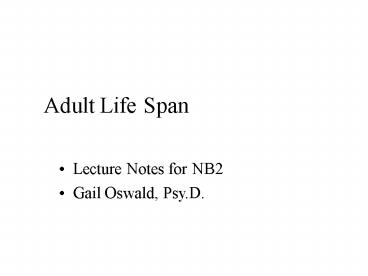Adult Life Span - PowerPoint PPT Presentation
1 / 26
Title:
Adult Life Span
Description:
Levinson: Season's of a Man's Life. The 'Dream' Deflation of the Dream ... and American women (1/3 of whom were teens) has more than quintupled since 1960. ... – PowerPoint PPT presentation
Number of Views:92
Avg rating:3.0/5.0
Title: Adult Life Span
1
Adult Life Span
- Lecture Notes for NB2
- Gail Oswald, Psy.D.
2
Adult Life Span
- Adult development
- Issues faced in adulthood
- Aging
3
Adult Development
- Erikson Psychosocial Development
- Intimacy vs Isolation
- Generativity vs. Stagnation
- Integrity vs. Despair
4
Adult Development
- Levinson Seasons of a Mans Life
- The Dream
- Deflation of the Dream
- Change of time perspective
5
Adult Development
- Vaillant
- Adaptation to Life (1977) Study of Healthy
Adults - Aging Well (2002) How we grow old - happily or
in misery - is more under the control of
ourselves, rather than our genes and upbringing
6
Critical Issues Adults Face
- Changing Family Roles
- Normal Aging
- Menopause
- Alzheimers
- Bereavement
7
What is a traditional family in the U.S.?
- ? single parent families
- ? birth rate for mothers aged 35-44
- ? Both parents working full time.
- High divorce rate
8
- TThe percentage of babies born to unmarried
British, Canadian and American women (1/3 of whom
were teens) has more than quintupled since 1960.
30
Percentage of births to unwed mothers
25
20
15
10
5
0
1940
1950
1960
1970
1980
1990
Year
9
50 of marriages in the U.S. end in divorce
- Negative effects of divorce related to degree of
conflict and not necessarily to divorce itself.
10
Effects of Maternal Employment
- Positive effects for daughters
- Negative effects for sons
11
Menopause
- increased depressive symptoms for women 45-50
associated with - physical inactivity, inadequate income, use of
estrogen/progesterone combination, and presence
of climacteric symptoms (trouble sleeping, mood
swings, or memory problems). - Menopausal status not associated with depressive
symptoms.
12
Aging
- Sociolgical Issues current change in
demographics - Physiological and cognitive changes associated
with aging
13
(No Transcript)
14
Adulthood- Cognitive Changes
Reasoning ability score
- Cross-Sectional method suggests decline
- Longitudinal method suggests more stability
60
55
50
45
40
35
25
32
39
46
53
60
74
67
81
Age in years
Cross-sectional method
Longitudinal method
15
Adulthood- Cognitive Changes
Intelligence (IQ) score
- Verbal intelligence scores hold steady with age,
while nonverbal intelligence scores decline
(adapted from Kaufman others, 1989).
105
100
95
90
85
80
75
20
35
55
70
25
45
65
Age group
16
Adulthood- Social Changes
- Multinational surveys show that age differences
in life satisfaction are trivial (Inglehart,
1990).
Percentage satisfied with life as a whole
80
60
40
20
0
15
25
35
45
55
65
Age group
17
(No Transcript)
18
(No Transcript)
19
(No Transcript)
20
Caregiving
- Number of caregivers is growing
- Many over 60 have living parents
- Women provide most of the care
- Average woman spends more years caring for
elderly than children - Caring for grandchildren is increasing
21
How will changing demographics impact your work
as a physician?
- Increase in single parent families
- Increase in number of women who are caretakers
for both young children and aging parents. - Five times more people in the over 65 age group.
22
(No Transcript)
23
Adulthood- Social Changes
- Kubler-Ross (1969) proposed that the terminally
ill pass through a sequence of five stages - denial of the terminal condition
- anger and resentment (Why me?)
- bargaining (with God or physicians) for more time
- depression stemming from impending loss
- acceptance of ones fate
24
Bereavement
- Normal grief may involve a number of physical
symptoms. - Insomnia
- Appetite changes
- Weight loss
- Psychomotor retardation
25
Which of the following changes can be viewed as a
normal part of aging?
- Decreased cognitive capacity
- Increased depression
- Increased fears of illness
- Increased agitation
- Decreased performance speed
26
Studies have shown that college students with
poor psychological adjustment are most likely
to 1) Develop more physical problems as
middle-aged adults.2) Outgrow the psychological
problems.3) Have improved sibling relationships
during their college years.4) Value
psychological health and promote health when
they marry.5) Develop good work habits to
compensate for feelings of inferiority.































